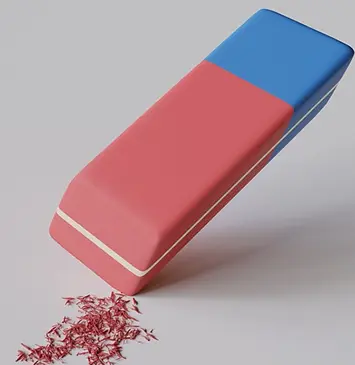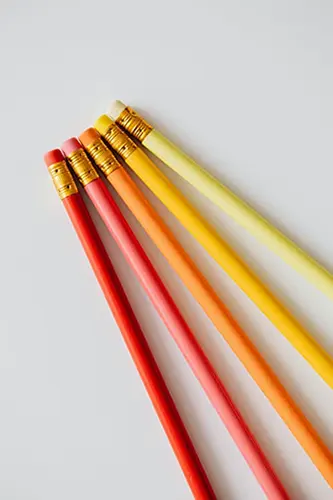You’re probably using it frequently but most likely you don’t know who invented eraser. Like many things we use daily, an eraser is one of those which we’re using without thinking about it deeply. So, who invented the eraser?
Rubber erasers were invented by coincidence. Though Joseph Priestly may have discovered the material’s erasing properties, the very first rubber eraser in Europe was successfully developed by British engineer Edward Nairne.
Many interesting facts are part of the eraser’s history and make this useful object’s story worth telling. Let’s see what we need to know about it.
Who Invented Eraser and Why?

The history of the eraser is a bit fuzzy. The earliest known version of an eraser was made from bread crumbs, which were used to clean up mistakes on paper.
Rubber was not discovered to be useful as an eraser until the 1770s.
In the same year, an English engineer named Edward Nairne found that rubber could remove pencil traces instead of breadcrumbs.
Nevertheless, this type of eraser did not perform well: it disintegrated when used and eventually died, it was far too reactive to weather, and it smelled horrible.
Later, in 1839, Charles Goodyear developed a method for curing rubber. It was called vulcanization.
Rubber became more resilient as a result of this procedure, allowing it to be used in household products such as erasers.
Rubber is a natural material that has been used in many different ways. The name “rubber” came from “rubbing” and was given to the object between 1770 and 1778.
Who Invented the Magic Eraser?
The Magic Eraser is a cleaning tool that was created by Mr. Clean in 2003.
These sponges consist of melamine foam, which is made from a compound called formaldehyde-melamine-sodium bisulfite copolymer.
This chemical can cause allergic reactions or irritate the skin if it comes into contact with it but doesn’t pose any long-term health risks.
Some of Magic Eraser’s most recognized benefits include its ability to remove permanent markers from walls and cast iron without damaging the surface and to remove caked-on messes from grout lines.
Who Invented the Pencil Eraser?
The pencil eraser is a great invention. It’s been around for over 150 years, and it’s still going strong.
The inventor of a pencil eraser with attached erase is Hymen Lipman.
On March 30, 1858, he was granted a patent for creating the first wood-cased pencil with an attached rubber eraser.
This revolutionary invention changed classrooms and art studios alike – and has been helping people make mistakes ever since!
Who Invented Rubber Eraser?

The rubber eraser was invented by Hymen L. Lipman in the 19th century.
Lipman, a New York City-based pencil salesman, noticed that his customers were often frustrated by smudged pencil marks.
He decided to create a small piece of rubber that could be used to erase these marks from paper; he called his invention an “erasable pencil.”
The idea of using rubber as an eraser was not new; however, Lipman’s innovation was in creating a small stick of rubber instead of simply using a piece of rubber as one would use a sponge or rag.
This made it much easier and faster to erase smudged pencil marks.
Who Invented Kneaded Eraser?
Charles Goodyear, an American inventor, is credited with inventing the kneaded eraser around 1839.
He was a prolific inventor who was most famous for his work in rubber.
The kneaded eraser is a rubber-based eraser that can be stretched and molded into any shape.
It works by picking up graphite from pencils, charcoal pencils, and other materials without smearing or damaging the paper underneath.
Who Invented the Whiteboard Eraser?
The whiteboard eraser was created by Jerry Woolfe, who was trying to find a way to make his dry erase markers more effective.
He thought that if he could create something that would remove all traces of ink from the board after use, he could make his product even better.
This led him to design an eraser that would use a sponge as opposed to cloth or paper. The whiteboard eraser works by pressing a small piece of sponge into the dry erase ink, removing it from the board, and leaving behind a clean slate.
When Was the Eraser Invented?
Many people are wondering when was the first eraser invented. The eraser was invented by accident. It all started with a pencil.
The pencil was invented in Germany in 1564 by Conrad Gesner and it was called a “pencil of lead.” The word “pencil” comes from the Latin word penicillium, meaning brush.
The earliest pencils were made from graphite mixed with water, clay, or wax to make them easier to hold.
The first eraser was made out of eraser rubber and was created by accident by an inventor named Charles Goodyear Jr.
He accidentally dropped his father’s candle on some rubber and noticed that it left no marks on the table where it landed.
This discovery led to the invention of rubber as we know it today!
The first commercial erasers were made from rubber in 1858 by Joseph Reckendorfer.
Where Was the Eraser Invented?
If you’re wondering where was the eraser invented, the answer is Philadelphia, Pennsylvania.
The eraser was invented in 1858 by Hymen Lipman, a Philadelphia-based inventor.
Lipman had been working on a method of making pencils out of rubber and gum arabic, and he needed to find a way to remove the excess material from the pencils.
He tried using a knife or razor blade to do this but found that it left marks on the wood.
He then used a piece of bread and rubbed it over the surface of the pencil to pick up the excess rubber.
He found that this worked well, so he decided to patent his invention for use as an eraser.
How do Erasers Work?
It’s not hard to understand how erasers work. To have a clear picture of it, it’s necessary to have a better understanding of the type of material of rubber.
They are usually built of rubber, however, plastic and vinyl are also used occasionally. To help the rubber last longer, it is generally mixed with sulfur.
To make the eraser extra pliable, a buffer such as vegetable oil is frequently added.
Lastly, abrasives such as grit are combined with dye to give the eraser a certain color.
As you brush an eraser along a pencil mark, the abrasives softly scrape the underlying fibers of the sheet, loosening the graphite particles.
These softeners inside the eraser serve to keep the paper from ripping while also maintaining everything neat and tidy.
Different types of erasers
Erasers are one of the most common drawing tools in all art mediums. They can be used for erasing mistakes, adding texture, and changing the color of a surface.
Erasers come in many shapes, sizes, and varieties. Today, we have a lot of different types of erasers on the market:
- Vinyl – Vinyl erasers have a soft texture and work well for light erasing. They’re not very durable and will break apart if you press too hard on them.
- Gum – Gum erasers are made from an agglomeration of rubber and chalks. These are the best for heavy-duty erasing.
- Nylon – Nylon erasers are softer than gum but not as soft as vinyl. They’re good for moderate-to-heavy erasing needs.
- Soft – Soft erasers are also known as plastic or polyvinyl chloride (PVC) erasers because they’re made from plastic polymers that are heated to form long strings of plastic resin which are then cut into small pieces.
- Rubber – ubber erasers are made from latex rubber — usually from recycled tires — and come in many different shapes, such as octagons or hexagons.
- Plastic – This is made of plastic particles fused together with heat and pressure; it has no odor or residue but can damage paper if not used properly.
- Kneaded – This is made of a composition of clay and pumice that can be kneaded into a pliable mass and used to erase graphite or charcoal without damaging the paper.
History of Erasers
The history of erasers is quite interesting.
Erasers have been around for a long time, but not until the early 19th century did they become mass-produced and widely available to the general public.
The earliest forms of erasers were made from rubber.
The first recorded mention of rubber comes from a Mayan codex dated 1552, although it is likely that rubber was used by the Aztecs as far back as 1350.
The Spanish conquistadors were fascinated by this new material and brought it back to Europe when they returned home.
Rubber was used in many different ways during this period. It was used to make shoes, boots, clothing, hats, and even condoms!
However, it wasn’t until 1770 that Goodyear came up with the process of vulcanization that made rubber more durable and waterproof than ever before.
This allowed people to use it for more practical purposes such as creating pencil erasers.
In 1856, Hymen Lipman patented an eraser made from compressed rubber mixed with soapstone dust which he called “blanc fixe.”
He sold them under the name “Lipman’s Eraser” at his store in Philadelphia until his death in 1868 at age 84.
Eraser Uses Today
Erasers are one of the most useful office supplies you can have.
Not only are they great for correcting mistakes, but they also make great multipurpose tools that can be used to clean up anything from your computer screen to your shoes.
Here are some of our favorite eraser uses today:
- Remove sticker gunk
Have you ever tried peeling off a sticker and then found yourself with a sticky mess? Well, the best way to get rid of that goo is with an eraser.
Just rub the tip over the sticker residue and watch as it disappears before your eyes!
- Clean up dirty shoes
Sometimes you just get caught in the rain or snow and end up with wet or dirty shoes. Rather than throwing them in the wash, use an eraser to clean them up first.
Just rub down any excess dirt or mud with the rubber side of an eraser and watch as it lifts away from your footwear.
You’ll be left with squeaky-clean shoes without having to do any work!
- Keep your keyboards clean
If you type all day at work, chances are you have some dust buildup on your keyboard. To keep this from happening again, take out an eraser and run it over each key until there
FAQs
If you want to find out more information about erasers, I’ve put together frequently asked questions about them, so you might find some cool information for yourself.
Where does an eraser come from?
Rubber erasers come from the sap of rubber trees, which are extracted and treated with chemicals to form a solid.
What was used before erasers?
Before rubber erasers were invented, people used a variety of materials to erase their mistakes. The Greeks used a piece of leather to erase ink from papyrus and parchment documents. The Romans used tablets made of wax or lead to remove marks from paper.
Can you eat erasers?
We’re going to say no. It’s because erasers are made of a substance called rubber, which is made from petroleum products and other chemicals. Eating a bit of eraser will not cause any symptoms, but if someone swallows a large enough piece, they may choke.
Why are erasers pink?
The color of erasers is a result of the particular type of Italian pumice that the company had sourced. Pink erasers were originally just an accident, but they quickly became a symbol of quality and craftsmanship.
Are white erasers better than pink?
The older style pink eraser has a higher concentration of clay and rubber particles in it which causes more damage to the page. When you use a white eraser on paper, it simply removes the graphite without scraping away any of the paper.
What is a blue eraser for?
The blue end is meant for erasing pencil marks on heavy grades of paper or dark marks. It is not meant to be used on lighter grades of paper as it may smudge the paper.
What is the best eraser in the world?
The answer to this question is subjective, but we can make a strong case for one particular brand: STAEDTLER Mars Plastic, Premium Quality Vinyl Eraser. This model has been around since the 1950s and has been consistently updated with new features.
Conclusion
In conclusion, erasers are quite useful and it’s cool to know their history. They are useful in the present and future as well.
I hope that you have enjoyed and appreciated my work of research on who invented eraser and I hope this information will come in handy.
However, if you still have any questions, leave a comment and I’ll gladly discuss it with you.

